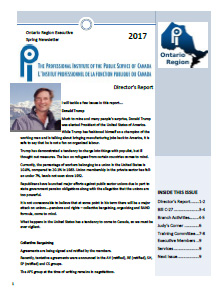Ontario Region Executive Spring Newsletter - Director’s Report
I will tackle a few issues in this report….
Donald Trump
Much to mine and many people’s surprise, Donald Trump was elected President of the United States of America.
While Trump has fashioned himself as a champion of the working man and is talking about bringing manufacturing jobs back to America, it is safe to say that he is not a fan on organized labour.
Trump has demonstrated a tendency to charge into things with populist, but ill thought out measures. The ban on refugees from certain countries comes to mind.
Currently, the percentage of workers belonging to a union in the United States is
10.8%, compared to 20.1% in 1983. Union membership in the private sector has fall- en under 7%, levels not seen since 1932.
Republicans have launched major efforts against public sector unions due in part to state government pension obligations along with the allegation that the unions are too powerful.
It is not unreasonable to believe that at some point in his term there will be a major attack on unions….pensions and rights – collective bargaining, organizing and RAND formula, come to mind.
What happens in the United States has a tendency to come to Canada, so we must be ever vigilant.
Collective Bargaining
Agreements are being signed and ratified by the members.
Recently, tentative agreements were announced in the AV (ratified), RE (ratified), SH, SP (ratified) and CS groups.
The AFS group at the time of writing remains in negotiations.
Things are moving along in collective bargaining, although it is likely slower than our members would like. This has been the pattern for a very long time, so it is not new.
Patience is required in collective bargaining with the Government. It is often said that “good things come to those that can wait”.
Due Increase
The 2016 PIPSC AGM approved a $10 a month dues increase.
It was felt that this level of increase was required to deal with the general increase in costs since the last increase, to support the building until it is re-leased and to deal with the Quebec lawsuit.
It is my hope that we will not have to go back to the membership for another increase for several years.
Quebec lawsuit
A lawsuit was launched against PIPSC many years ago with respect to a “sick out” by PIPSC veterinarians in the Province of Quebec.
The lawsuit was settled earlier this year on what I consider to be very favourable terms.
PIPSC Building
Approximately 2/3 of the PIPSC building in Ottawa was rented out and there was one tenant, the Federal Government. The lease expired on December 31 2016 and it was not renewed.
The space at this time is unoccupied and the lost rent and cost recoveries amount to amount to approximately $200,000 per month or $2,400,000 a year.
The Government of Canada, a major leaser in the Ottawa market, has reduced its leased space as a result of Workplace
2.0 – the drive to reduce workers’ real estate footprint.
Our building is an “A” class building and there has been significant interest in the space. Very soon, an LRT stop will open steps away from the office.
I expect this to be a short term situation.
Better Together, Peter Gilkinson, Ontario Region Director
Bill C-27 Target Benefit Pension Plans
The good news is that Bill C-27 does not apply to you.
The bad news is that Bill C-27 may apply to you sometime in the future, so it is important that you understand it
There are currently no provisions for shared-risk (Target Benefit) pension plans for federally regulated pensions.
Defined-benefit pensions provide stability and security to employees because employers are legally obliged to fund employees’ earned benefits. Already earned benefits are legally protected
Bill C-27 an Act to amend the Pension Benefits Standards Act, 1985 was introduced in the House of Com- mons on Oct 19th, 2016. It amends the Pension Benefits Standards Act to provide a framework for the es- tablishment, administration and supervision of Target Benefit plans
Bill C-27 applies to Crown corporations – Canada Post, CBC, Via Rail, etc and federal private sector employ- ers. As such, Bill C-27 does not apply to Federal Government employees
The characteristics of a Target Benefit (TB) plan are……
- The legal requirement on employers to fund plan benefits is removed.
- If the plan develops a shortfall, and contributions are not high enough to pay for the promised benefits, additional payments into the plan made by the employer may be capped, or not permitted at all.
- Instead, benefits may be reduced on both a going-forward and retroactive basis, including pensions-in-pay to retirees.
- Employees are often required to pay higher rates of contributions, for a lower pension benefit.
- Indexing of pensions is no longer guaranteed, and is subject to the rate of return on investments annu- ally.
- TB pensions effectively shift the risk from the Employer to employees, and are less predictable and more risky for workers and retirees.
In 2012 the New Brunswick government passed legislation which allowed for the conversion by both pri- vate sector and public sector Defined Benefit plans to so called “Shared-Risk” (Target Benefit) pension plans.
Bill C-27 seeks to accomplish two major objectives in relation to target benefits (“TBs”).
- It creates a new structure that allows for single employer TB plans.
- Bill C-27 creates a process for converting member entitlements in defined benefit (“DB”) plans into tar- get benefits (“TBs”).
- Bill C-27 also deviates from Canada’s historic practice vis-à-vis TB plans by not requiring that TB plans be jointly governed.
At the same time Bill C-27, allows the employer to retain majority control over the fiduciary board of a
TB plan. It need only provide for the appointment of a single representative for active plan members and a “prescribed number” of representatives of the plan’s former members and survivors.
Bill C-27 requires individual workers to give their consent to give up their DB benefits.
Employers could use “threats” to force DB plan member’s hands if they don’t surrender their benefits for the good of the company, such as:
- potential job losses
- reduced hours of work,
- reduced investments,
- scaling-back benefits,
- threats of lockouts,
- restructuring proceedings, or
- Bankruptcy.
Branch Activities
Toronto North – Bargaining Support and Wellness Fair

- Joel Reisman, Toronto North President with Din Kamaldin, Vice-President
Hamilton/Burlington Branch
The PIPSC Hamilton/Burlington Branch held its Annual General Meeting on February 28th in Burlington at the Black Bull Convention Centre. Of special note at this meeting we had Burlington MP and Federal Minister of Democratic Institutions Karina Gould attend as our keynote speaker.
Ms. Gould was elected as an MP in Burlington in the fall of 2015 and in January of 2017 became the youngest ever female Minister in Canada at the age of 29 when she was appointed by the Prime Minister as Minister of Democratic Institutions. With this portfolio she is charged with working on electoral reform, reforming the Sen- ate, and other duties.
Her speech was inspiring and her energy and enthusiasm was uplifting. Ms. Gould noted how the federal gov- ernment is making its decisions based on evidence. She explained that she is a champion of government science and is especially proud of the work of scientists and other public servants at the Canada Centre for Inland Wa- ters. She remarked on its international notoriety by telling a story of while travelling in a country in Africa of a foreign minister acknowledging that her home riding of Burlington, Ontario was where the Canada Centre for Inland Waters was located.
In regards to electoral reform in Canada, she explained that the government has chosen not to reform the elec- toral process at this time, referring to a national consultation process where approximately 380,000 Canadians participated in a poll on mydemocracy.ca. Many who took the poll were supportive of change while many were not. There was a healthy discussion with the PIPSC members present at the meeting and she was pressed on the government’s decision to not take action at this time, responding that there is still work to do in this area.
Following her speech, she stayed for some time to interact individually with those at the meeting and was also witness to the election of the new executive of the Hamilton/Burlington Branch. The Hamilton/Burlington Branch does not always need an election but this year it was only fitting with the Minister responsible for Demo- cratic Institutions including elections in Canada present at our meeting that enough members were nominated so that an election was required!
Submitted by Aaron Thompson, President Hamilton/Burlington Branch

Hamilton/Burlington Branch President Aaron Thompson and Karina Gould, MP
Judy’s Corner
The Fall brought many changes on the international scene as well as issues close to our own hearts. Close to home in December, six Core Public Administration Groups (RE, CS, AV, NR, SP and SH) along with the AFS Group, met with Treasury Board representatives simultaneously. RE, AV, SP and SH and soon to follow in March, the CS group negotiated Tentative agreements (and all but the latter have been ratified.). The support across the board for all groups was tremendous shows of support on social media helped bolster the bargain- ing teams during late night negotiations with Treasury Board and showed we are organized and we care about our CAs! Each agreement is as unique as a snowflake which adorned members’ walls!
On a global scene, the sea of pink "Pussy hats" at Women's marches in Canadian cities, Washington and around the world on January 20, 2017 signaled that 5 million people marched in together and their presence and voices were heard! A reflection of the unity and strength of the common people together, vocalizing sup- port for issues that are current and right in the world. PIPSC was there in several cities and at Queens Park!
Let's remember every one of us can make a difference and collectively our voices can be a catalyst for greater good! Next is the “March for Science” on April 22. If you can, carry a PIPSC banner and get out there to show that Science Matters!
http://craftingunions.wordpress.com

Training Committee Column
PIPSC FOR DUMMIES
Disclaimer: This is meant to be an introduction for newer Stewards and Members. In the interest of brevity and simplicity, and me naively bragging to the Regional Exec that I could sum it all up in 5 paragraphs, I’ve purposely not touched on: National or Regional staff structures, Committees of the Board, the Advisory Council (AC) and Working Group on Consultation (WGC), the Executive Committee (EC), the Annual General Meeting (AGM - the supreme governing body of PIPSC) etc. We’re only going to be scratching the surface here - but hopefully it will help you have a better understanding of PIPSC than I did when I started out.
“ORGANIZATION IS THE SPICE OF LIFE“- Alex Maksymiw
It takes a little a while to understand how PIPSC works. Speak to new and experienced stewards alike, and you will find consensus on this - it’s complex. We’re an organization consisting of close to 60,000 members, working for 27 differ- ent employers, representing 41 different “knowledge groups” at all levels of gov’t as well as outside of government, so you can see that it’s no small task to set up a political structure to serve and be representative of all of our members.
What we currently have is referred to as a parallel structure - essentially consisting of two ‘tracks’ that, although they
‘run parallel’, often criss-cross and intertwine. You know them as Groups and Regions but for the purposes of this arti- cle it’s helpful to think of them in terms of the ‘WHAT?’ track and the ‘WHERE?’ track. The ‘WHAT’ represents the type of work you do and the ’WHERE?’ represents the geographic location in which you do it. (There is also an invisible third track - the ‘WHO?’ track, as in ‘WHO’ do you work for? However, this falls into the realm of Consultation and is an arti- cle I will tackle in an upcoming column - I did mention that I’m doing this in only five paragraphs!!)
THE WHAT
“The structure by Group allows each bargaining unit to determine its bargaining priorities and strategies, and to deal with current concerns specific to its members’ profession.”
Members belong to Groups and their Group makes up their bargaining unit. Groups operate under a Constitution that must be consistent with Institute By-Laws and hold their own elections and AGMs. For the most part, Groups are made up of one or more job classifications that constitute similar knowledge disciplines. For example the AV Group (Audit, Commerce and Purchasing) consists of AUs, COs, and PGs that bargain together. At the local levels, Sub-Groups may exist as a local representation of a Group. Sub-Groups normally report to the Sub-Group Officer of a Group's Executive.
As defined in PIPSC group policy, the aims of a Group shall be:
- to further the professional interests of its members;
- to protect the status and standards of their professions;
- to formulate and express the views of the members on matters affecting them; and
- to ensure that the interests of the Group are represented in all proceedings of the employer and of the Institute that may affect the Group.
THE WHERE
“The structure by Region allows the issues and interests specific to a particular geographic Region to be reflected in the Institute’s broader concerns.”
The Institute is comprised of six geographical Regions: Atlantic, Québec, Ontario, National Capital, Prairie/Northwest Territories and British Columbia/Yukon. Regions provide a minimum of three levels of organization consisting of: the Regional Council, the Regional Executive and Branches. For the most part, regions are responsible for Steward Develop- ment, Recruitment and Training.
The regional structure also allows us to coordinate steward development and member representation in tandem with our regional offices in the most cost-effective approach. At a more local level, Branches operate as a subcomponent of a Region and are meant to advance the aims and issues of the region. Depending on the need, size and geographical distribution of the members, a Branch can be contained in one building, a part of a city, a city or even an area encom- passing a few cities. Normally, a Branch would consist of members of more than one group. As defined in the PIPSC policy on Regions, the Aim of a Region is:
- to support and further the aims and objectives of the Institute
- to ensure that the views, concerns, and needs of the membership in the Region are represented at Council, PIPSC Annual General Meetings, meetings of the Board of Directors, and at meetings of other decision-making bodies of the Institute
- assist in the coordination of Branch activities
THE LAST WORD
Hopefully this helped...or at least didn’t make things more confusing. I tried to stick to the basics as much as possible but there are a few exceptions to things I talked about. It’s a somewhat impossible to condense 60 pages of bylaws, 100s of pages of policy and policy statements to 5 paragraphs. You also have to keep in mind everything I just ex- plained could be changed at any point by a simple majority vote on a resolution at the AGM. At which point I’ll start on a new article, until that happens, that’s what we got. If you are interested in learning more about the Who, What, Where of PIPSC and see where I ‘lifted’ most of this article from - here’s a few good starting points;
What: http://www.pipsc.ca//groups
Where: http://www.pipsc.ca//regions
ONTARIO REGION EXECUTIVE
Peter Gilkinson - Chair & Director - Ontario Region Executive
Din Kamaldin - Vice-Chair - Ontario Region Executive
John G. Purdie - Chair - Ontario Regional Council, Branch Liaison Officer & Newsletter Editor
Linda Joly - Vice-Chair - Ontario Regional Council & Event Co-Ordinator
Tom Yantsis - Treasurer
Tim Azab - Training Committee Member
Christopher L’Estrange - Secretary
Nivin Fouad - Training Committee Member
Pete Jozsa - Chair - Training Committee & Ontario Steward Council Coordinator
Yvonne Snaddon - Training Committee, Branch Liai- son Officer & Newsletter Editor
Dean Corda - Training Cttee Recording Secretary, Branch Liaison Officer & Newsletter Editor




